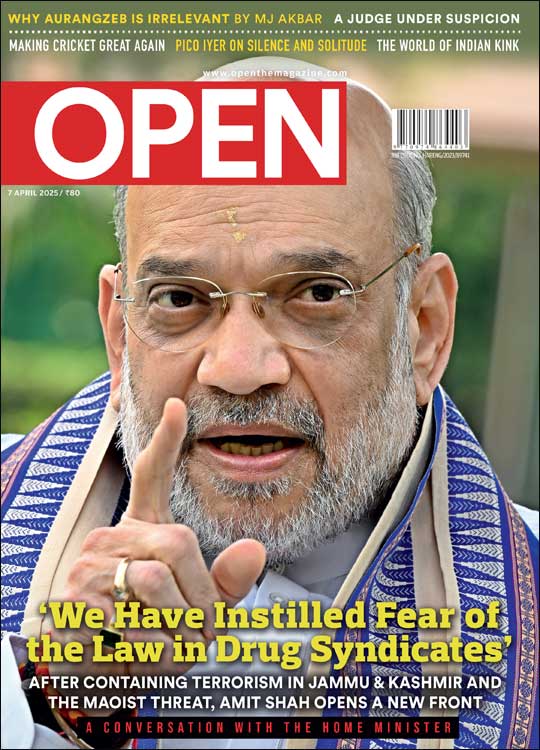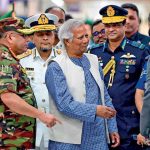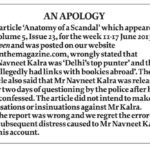REACHING FOR THE STARS
A political reporter from Patna today runs India’s top TV network
 Lhendup G Bhutia
Lhendup G Bhutia
 Lhendup G Bhutia
Lhendup G Bhutia
 |
24 Dec, 2014
|
24 Dec, 2014
/wp-content/uploads/2015/11/Reachingstars1.jpg)
A political reporter from Patna today runs India’s top TV network
As Uday Shankar walks into the unfinished and forbidden terrace of Star House, there is an amusing look of incredulity on the face of the security guard whose job is to restrict entry to this area. Shankar, CEO of Star TV India, has never been on the terrace. And the guard in all likelihood has never been on Shankar’s floor. Seemingly unsure of what course of action he should follow, the guard stands up, perhaps to register a forbiddance, fidgets as though he is unsure if he should offer some pleasantries, accompanies us a few paces, but eventually returns to his seat without speaking.
We climb tiny inconvenient steps to reach the terrace that stands above the unfinished 40th floor of this imposing building. Shankar almost races ahead, while his female companions totter on their large heels, first on the steps, and later against the breeze on the terrace. After we complete the photo-shoot, his companions appear to want to leave the place. But Shankar stands, his elbows resting against an unfinished wall. “Look at that view,” he says. Below you can see Bombay in all its grandeur and hopelessness. Tiny figures of traffic that halt more often than they move, old rattling trains carrying people home from work, a cluster of buildings shooting up around Mahalaxmi Race Course, and a gorgeous sea at a distance almost as though containing an exploding city. “Isn’t that a great view?” he says, pointing to the distant setting sun.
As we walk down, Shankar is the only one to thank the guard.
Several decades before Uday Shankar began his career as CEO of what is perhaps the country’s most successful television network, even before he became part of the tele- vision news industry that revolutionised the way the country consumed news in the late 1990s, he began his professional life with a failure. He sat for the UPSC examination like every other young man of reasonable intellect from a small city. And he cleared the preliminary and main rounds too. But even though some of his friends were selected, Shankar failed at the interview. “I have always been a little too sharp of the tongue and quick on the repartee. And I think I was too cocky at the interview,” he says, refusing to elaborate—out of embarrassment, he admits—on what went wrong. “That’s when I realised I had to take charge of my life.”
Until then, Shankar had breezed through life with little care. Born to a civil engineer and homemaker, he was, according to himself, curious about the world from a young age. “I had three vices, really, as a kid—Newsweek, Time magazine, Far Eastern Economic Review,” he recalls. “And most of my classmates were then still reading comic books.” But he lacked the ambition his father so desired in him. He moved to Delhi to pursue a Master’s degree in Economics at Jawaharlal Nehru University, but continued to lead a life of little worry. He got himself a two- wheeler, hung out with friends, often plied himself with whisky, but rarely considered where his career was going. “So when I failed at the UPSC, it really shook me up. I started to reconsider where my life was headed,” he says. He realised that he wouldn’t enjoy the job of a civil servant, if he ever got selected for it. So instead of preparing for the civil services’ examination again, he chose, much to his father’s disappointment, a job he thought his curiosity and interest in current affairs would be more naturally inclined to. After completing a course at Times School of Journalism in Delhi, he found himself on a train to Patna, to become a political correspondent for The Times of India.
Shankar is leaner in reality than he appears on TV and in newspaper pictures. As the 52-year-old walks down a passage that leads from his office to his conference room, the military clatter of his shoes filling the air, he chats with colleagues who work on the floor with informal familiarity. It feels more like a newsroom crowd than that of a staid corporate house. He is dressed in a formal blue shirt and dark trousers, and wonders if he can leave the top button of his shirt undone for a photograph. His office exudes luxury, with a seating area for him to entertain guests and a desk beside a glassed-in sun porch where he can work, drinking coffee that is poured by gloved hands into mugs with ‘Star TV’ embossed on them.
In many ways, Shankar’s career mirrors the rapid changes that have occurred in the country’s media industry. He learnt journalism at various publications before shifting, like other ambitious journalists, to the then exciting new industry of TV news. Over the next few years, Shankar would work his way into various news channels, overseeing and bringing about changes in the technology and content of Indian TV news, and ascend to become one of the top editors in the business. The careers of most journalists would have reached a plateau here. But Shankar became part of another industry, a larger one, and another revolution. Shankar became Chief Executive Officer, unheard of for a journalist in India, of a multi-million dollar entertainment company that has a bouquet of 34 channels in seven different languages and which reaches roughly 650 million viewers every week. Shankar became the top boss of Star India.
When Shankar joined The Times of India as a political correspondent, he was focused on his career, but was still ‘trouble’ for management. He became involved with the local journalists’ trade union, demanding better wages for journalists, and later protested against the paper’s management when some of his colleagues lost their jobs. Over the next few years, he moved to a string of other publications in Delhi, covering various beats, from politics and health to the environment, and also became one of the founding editors of the environmental magazine Down To Earth. Television news was opening up to Indians at this time and Shankar wanted to join it.
“When I was still working with The Times of India in Patna, I was once in Delhi for a while,” he says. This was in 1991, during the First Gulf War. Shankar was too poor, in his words, to afford a TV set. So he began to frequent the house of a friend who owned one with a cable connection. “We would sit in front of the TV, tuned in to CNN, watching with amazement at the coverage of the war by the channel,” he says. “The visuals of a war, perhaps being witnessed by many around the world for the first time, the reporters standing on location signing off their PTCs (piece to cameras)—it completely blew my mind. I knew I wanted to be in such an industry.”
Shankar also began to frequent the sets of televised current affairs programmes in India. He once even became a part of the audience for current affairs shows for Doordarshan. “I was getting drawn to the medium. Everything about it, from its lighting and cameras to the urgency of the news, began to captivate me,” he recalls. “I used to speak about it so often to my wife that one day she told me if I liked it so much, why didn’t I join it.”
Shankar began his career in the TV news industry at Zee TV as a news producer. He began to rise rapidly, rarely ever sticking to one job for too long, moving as a producer and later as a news editor and executive. He went from Zee TV to Home TV, then to the production house Shri Adhikari Brothers, and from there on to Sahara TV, Aaj Tak and Headlines Today, and finally Star News. Recently, Aroon Purie, Chairman of the India Today Group, which owns Aaj Tak, spoke about his impressions of Shankar to the media news portal Exchange4media. He said, “I think I am a pretty good judge of people… but the one person I misjudged was Uday Shankar… I found him to be a person who is passionate about journalism and passionate about news… He was from JNU, I wouldn’t say he was a leftist, but he had kind of imbibed some of the leftist ideology, and I thought he was the last person to be a big corporate leader in India because he was not really a corporate person. He was the kind of person who was a free spirit, who said, ‘I never hold a job for more than three years in any particular place’, kind of a moving person who likes to do different things at different times…”
Shankar was director of Aaj Tak when it launched in 2000, and helped set up its English-language counterpart, Headlines Today in 2003. While at Aaj Tak, he is widely considered to have kicked off the phenomenon of ‘Breaking News’ in India, where the news was relayed instantly, something that other channels began to emulate. He says, “An event on TV was never instant then. There were no OB vans like those you see today and the technology to beam a feed directly into TVs at homes did not exist in India then.” “But when the Gujarat earthquake occurred in 2001, we at Aaj Tak were able to, with the help of broadband cables, show what was happening almost instantly. That feeling of doing something new was exhilarating.”
When the media baron Rupert Murdoch of News Corp purchased the Hong Kong-based Star TV in 1992 for almost $1 billion, he wanted to expand his media empire and create a truly global satellite network. He was particularly focused on China, which he visited often and whose leaders he courted extensively. Some even claim his marriage to Wendi Deng, his third wife who worked as a Star TV executive and whom he has now divorced, was motivated by that.
But Murdoch and Star TV burnt their fingers in China. Faced with legal regulations that prohibit foreign stations from buying domestic media outlets, as well as attempts to control content, it became clear after 2010, when Murdoch sold control of Star China TV to China Media Capital, that he was on his way out. Earlier this year, it was announced that Murdoch was selling his remaining stake—47 per cent—in the company. Murdoch’s focus is now entirely on Star India, which in comparison with Star China TV has been doing remarkably well.
But it wasn’t all that good, even in India. In fact when Shankar was asked to take over Star India in 2007, many believed it was a stop-gap arrangement. The performance of the entertainment channel was dipping, the ratings of its shows were low, revenues were shrinking and rival channels were pulling a march on it. The fact that the jobs of Peter Mukerjea and Sameer Nair, the two big names associated with the entertainment channel’s set-up in India, who performed the separate and independent roles of looking after the programming and the running of Star India, were being combined and offered to someone who only had news industry experience appeared perplexing to industry watchers.
“All sorts of rumours were doing the rounds,” he says. “From how I would not last long to how the company would wind down its business in India.” But Shankar has turned the fortunes of the firm around. It is not just the leader in the category of entertainment channels, its various channels draw large revenues; it is also, through an eclectic mix of content like the Aamir Khan- hosted Satyamev Jayate, investing for the future. Shankar has also become an influential industry leader, currently serving as President of the Indian Broadcasting Foundation (IBF), who has used his clout to effectively lobby for a switch from analogue broadcasting to digitisation, a move that’s expected to benefit all TV entertainment companies.
However, when Shankar was offered the CEOship of Star India, he had no experience in working with an entertainment television company of this size. He had never even watched a Hindi TV soap opera. “So I did what I did as a journalist when I didn’t know something,” he says. “I admitted I didn’t know and began to learn.” Among other things, he prescribed himself a daily minimum of an hour of soap operas, something he says he continues to do today. He uploads all the newest shows on his iPad and watches them as he travels. “As a journalist, you do such a wide spectrum of things. It was like the editor who told you ‘Go and cover such and such beat today’. In my case, it was like covering entertainment,” he says of the time he was offered the job. “So I sat down, followed it and tried to learn what worked and what did not.” Shankar also quickly identified other problem areas. Star was overdoing the kitchen politics of TV soap operas. Cable and satellite TV had spread to smaller towns, but the programming was still largely aimed at metro audiences. “Every time the ratings were down, they’d do a show of [Kaun Banega Crorepati] to pump it up. The place was almost dead and people were living in denial.”
Star India was then contractually bound to Ekta Kapoor’s Balaji Telefilms to only telecast content made by the TV production house. In return, Balaji would only sell its content to Star India. When Shankar came on board, he did the unthinkable. He severed ties with Balaji Telefilms to also telecast content from other production houses. He also had iconic TV shows like Kyunki Saas Bhi Kabhi Bahu Thi, Kasauti Zindagi Ke and Kahani Ghar Ghar Ki wound up. Even KBC was stopped for several years. He instead brought in fresher content, TV shows that were more socially relevant and the female protagonists were more powerful, and went after new audiences. He says, “The relationship of content with those who consume it, I began to realise, whether it be news or entertainment, is not radically different. In news you brought the news of the day. In TV shows, you treated that news as elements of a fiction show.”
That experiment with content continues till today, its most notice example being when he roped in Aamir Khan, to— unlike other channels that brought in stars for tried and tested formats—do a non-fiction show where social ills would be examined and discussed. When Shankar came up with the idea of Satyamev Jayate and began to discuss the concept, it is said that one of his colleagues claimed he was ‘totally out of line’. The show was an unusual marriage of sorts between journalism and entertainment, it was to be telecast on Sunday mornings, and each episode, it is rumoured, costs at least Rs 5 crore to make. Shankar had to take the concept to James Murdoch, the co-chief operating officer at 21st Century Fox which owns Star India (and son of Murdoch), to get a go-ahead.
Since then, the show has achieved remarkable success. Having just completed its third season, its viewership of the first episode of Season 3 was 4.9 million. The opening show of the second season, in March this year, had 4.8 million viewers.
Shankar continues to place studied bets. Last year, Star India announced that it was going to invest Rs 20,000 crore in sports—not just for telecast rights, but also to create sports leagues. So far, Star has, with other organisations, thrown its weight behind the Indian Badminton League, Hockey India League, the Indian Super League for football, and the Pro Kabaddi League. “Everyone says India is an only cricket-watching country. But that isn’t necessarily true. We don’t watch matches that don’t feature the Indian cricket team. We don’t watch domestic matches or tournaments that feature other international teams, apart from the IPL (Indian Premier League),” he says. “The only reason we follow the Indian team with such intensity is because, much vilified as the BCCI is, as a sports body it has been able to build people’s interest in that game. We thought that instead of cribbing about how Indians don’t watch other sports, why don’t we produce our own sporting leagues and build people’s interest in them?” To the surprise of many, the Pro Kabaddi League has been quite a success, gaining 435 million viewers over the 37-day period of the tournament, a figure that makes it the most-watched Indian live sports event after the IPL with its peak viewership of 552 million. According to Shankar, these programmes will take a while to become profitable. “For now,” he says, “they are all investments for the long run.”
About The Author
CURRENT ISSUE
‘We Have Instilled Fear of the Law in Drug Syndicates,’ says Amit Shah
MOst Popular
4

/wp-content/uploads/2025/03/Cover_Amit-Shah.jpg)











More Columns
Elon Musk attracts sharp attack over ‘swastika’ from Indians on social media Ullekh NP
Yunus and the case of a "land locked" imagination Siddharth Singh
Why CSK Fans Are Angry With ‘Thala’ Dhoni Short Post